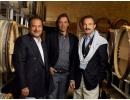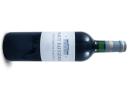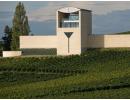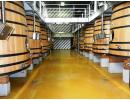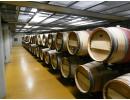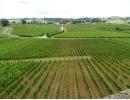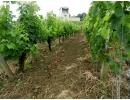Haut Faugeres
Haut Faugères 2014 - Saint Emilion Grand Cru
A blend of 85% Merlot with 10% Cabernet Franc and 5% Cabernet Sauvignon. As the second label of Château Faugères a Saint Emilion Grand Cru Classé since 2012, the management of the vineyard and winemaking process are the same. The The vines are on average 20 years old producing a yield of 27 hl/ha on average. The harvest is hand-picked and sorted twice at the cellar. Once the grapes are destemmed, the must will undergo a pre-fermentation skin maceration at 10°C for 3 to 4 days to extract colour, flavours and structure. The fermentations will last about 3 weeks at 28°C to 30°C in conical oak vats. The wine will then be aged in french oak barrels for 14 months which are one and 2 years old.
PVins notes: The wine shows expressive ripe fruity aromas with well integrated oak, its elegant tannin structure is classic of a Bordeaux wine from the right bank combined with a little touch of "New World" in style by its richness. The wine may be cellared for up to 15 years depending on the vintage.
The cuvée Haut Faugères, created in 2004, is the second label of Château Faugères a saint Emilion Grand Cru Classé since 2012. The château is located 6 kilometers to the east of the village Saint-Emilion close to St Etienne de Lisse. The property can be traced back to at least 1823 when it came under the ownership of the Esquissaud family. In 1987 Pierre-Bernard Guisez, known as Péby inherited the estate being a cousin of Philippe Esquissaud. Following the sudden death of Péby in 1997, his wife and daughters created in 1998 a premium wine in his honour named “Cuvée Speciale Péby” today known as “Peby Faugères”, now also a Grand Cru Classé since 2012. The wine is made from the best plots of Merlot available on the estate. Château Faugères remained in the hands of the family until 2005.
A new chapter began in 2005 for Château Faugères when the Swiss businessman and wine connoisseur Silvio DENZ purchased the Château Faugères already a Grand Cru at this stage. Determined to keep the reputation and continue to produce high quality wines, he requested the Comte Stephan Von Neipperg, owner of the highly reputable Château Canon La Gaffelière and Michel Rolland one of Bordeaux’s top oenologist to be the estate's wine consultants. Their contribution has enabled the château to maintain and improve the high quality wines it produces. In 2012, following the official Classification of the Grand Cru Classé of Saint Emilion, both Château Faugères and the cuvée "Peby Faugères" were finally classified as Grand Cru Classé wines.
The vineyards of Château Faugères cover 37 ha in Saint Emilion made up of 47 parcels. The vineyard is cultivated by means of natural sustainable viticulture, involving integrated cultivation and meticulous care on the part of the proprietors. Château Faugères has an excellent terroir with a mix of clay and limestone soil. The vines situated on the limestone plateau of Saint Christophe have a subsoil composed of asteria limestone dating back to the lower Oligocene. Those planted on the slopes facing south-southeast in a circular formation are on clayey-limestone soil, while those planted in the plain are on clay and limestone molasse from the upper Eocene and Oligocene eras.
The new monumental winery designed by Mario Botta resembling a "Cathedral for wine" is situated at the top of the plateau overlooking Château Faugères. It was build to serve the purpose of the never-ending quest to improve the quality of the wine at every stage of production, deploying the very latest technology. Michel Rolland also worked on the specifications, with absolute priority given to the capacity, the layout and the optimisation of internal procedures. New sorting tables to pick unwanted berries are in place, the must is poured into the fermentation vats by gravity and not pumped. The new functionality of the cellar, with its conical oak vats, enables the estate to work on a "parcellaire" approach, meaning plot by plot. Also to maintain the quality of the fruit every parcel is hand harvested and looked after individually.
The cuvée Haut Faugères is made with the same attention and care in the wine making process as Château Faugères. Its blend of Merlot, Cabernet Franc and Cabernet Sauvignon and the barrel ageing period is also the same as the main wine but without new oak. The only difference is that it is made with the younger vines and the parcels that will not be used to produce the main wine Château Faugères. This does not take away its quality and potential as it is still classified as a Saint Emilion Grand Cru by the appellation's regulation. The wine shows expressive ripe fruity aromas with well integrated oak, its elegant tannin structure is classic of a Bordeaux wine from the right bank combined with a little touch of "New World" in style by its richness.
Links: AOP Saint Emilion - Saint Emilion map - Libournais map - Bordeaux map
SAINT EMILION
The appellation Saint Emilion was created in 1936 situated in the Gironde department. It is located some 40 kilometres northeast of the city Bordeaux on the right bank of the Dordogne river in the sub-region of Libournais. Its famous neighbour is the appellation of Pomerol. The vineyards cover about 5,200 hectares spreading over nine communes. Only red wines are produced in the appellation giving some of Bordeaux’s best Merlot based wines such as Château Cheval Blanc, Château Ausone and Château Angélus, just to name a few, are found here. Since 1955, Saint-Emilion hasits own Grand Cru Classé classification which is revised every 10 years, the most recent classification being 2012. There is also a "Grand Cru" status which any wine can claim as long as they are produced according to the Saint Emilion Grand Cru appellation criteria. The village of Saint Emilion and its surroundings were added to the list of UNESCO’s World Heritage Sites in 1999.
History
Viticulture in the area can be traced back to the Roman times. The famous Roman poet and teacher Decimius Magnus Ausonius (AD 310 - 395) had an estate that supposedly included the land now owned by the famous Château Ausone, which takes its name from him. There is a legend that tells us about a monk from Brittany who fled from Vannes, his hometown, to seek refuge in one of the natural caves in a place called Ascum bas (former name of the village) in the 8th century. His name was Emilion. Living the life of a hermit he accomplished a few miracles and rapidly became famous in the region and even far beyond its borders. Soon he had many disciples and the village became a great religious centre. Even after his death his followers carried on his legacy and even called the town after him: Saint-Emilion. Today, if Saint-Emilion wines are world famous it’s also thank to the hard promotion work of the "Jurade", a wine brotherhood that was created in 1199 by John King of England as the region was under English rule. He delegated his economic, political and legal powers to the noblemen of the region and the village. In 1789, the authority of the Jurade was contested during the French Revolution, but in 1948 a few winemakers resurrected the brotherhood which is now in charge of promoting the Saint-Emilion wine around the world.
Vineyard
The topography of Saint-Emilion is slightly hilly with a plateau and hillsides which helps the drainage in certain types of soil. Most of the classified Grand Cru Classé (Growth Wine) properties are set on the plateau around the village with its Tertiary era limestone bedrock or on south facing slopes.
There are three types of soils in the appellation:
- The plateau: clay-calcareous rich with decalcified loamy clay in some areas.
- The slopes: upper part is clay-calcareous rich on a soft limestone bedrock and the lower part is sandy-clay and loam with sedimentary bedrock.
- The plain: sand and gravel from alluvial deposits during the recent Quaternary era.
The Merlot is king here as it is well suited to the clayey-limestone soil and cooler climate, compared to the Médoc on the left bank of the Gironde Estuary. It is often blended with Cabernet Franc and sometimes Cabernet Sauvignon. The Merlot offers incomparable aromatic richness, colour, suppleness and crispness on the palate. Its bouquet immediately releases aromas of ripe red and black fruit and flowers, developing into fig or plum notes after a few years of cellaring. The Cabernet Franc with its fresh bouquet and tannins offers a perfect structure and ageing potential. As for the Cabernet Sauvignon, it is well-suited to hot and dry soils, it offers spicy notes and rich tannins that will give the wine structure, enabling it to age well for a long time.
Climate
The Libournais region benefits from the temperate oceanic climate from the Atlantic Ocean. It is marked by moderate temperature differences between summer and winter, with rainfall well distributed throughout the year. Hot summers, warm autumns and protection from the Dordogne river minimising the risk of frost, are all favourable elements for a perfect ripening of the fruit. However, this microclimate remains subject to climatic variations. From one year to another the differences in temperature and rainfall can be significant, therefore influencing the quality of the vintage.




